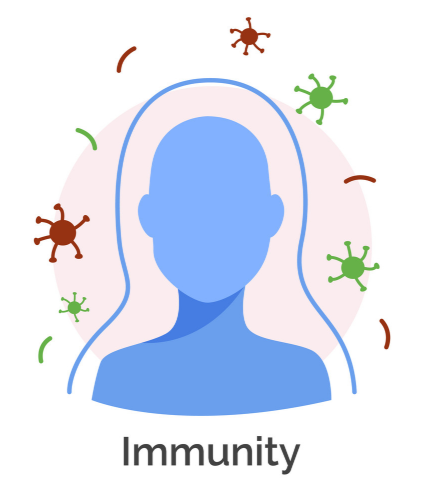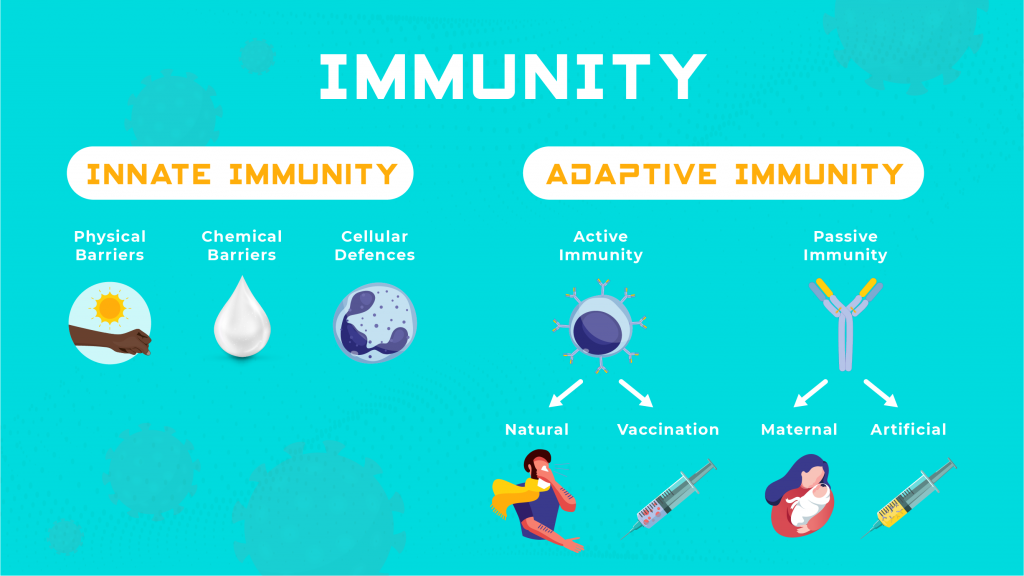The mechanism used by the body as protection against environmental agents that foreign to the body. Immunity is a state of protection against foreign pathogens or substances (antigens).
It responds to threats on an individual basis.
Term immunity derived from – Immunis, meaning Exempt.
Immune system is remarkably versatile defense system that has evolved to protect animals from invading pathogenic microorganisms and cancer.
Types of Immunity:
- Innate immunity: primitive immune system which is less specific
- Adaptive immunity: highly evolved system of specific response
Innate Immunity
- Also called Native
- Resistance possessed by an individual by birth i.e., inherited
- Provides first line of defense against infections
- Genetically determined: no prior exposure or antibody production involed
- 3 levels:
Species immunity: entire human species is resistance to plant pathogen.
Racial immunity: particular races of that species are resistant. Example: Negroid species in USA is more prone to TB than causcian species.
Individual immunity: evident on twin – smiliar degree of resistance to TB or leprosy.
- They are always present and available at short notice to protect the individual from challenges by foreign invaders
- Elements of innate immune system includes body surfaces and internal components, such as: skin, the mucous membrane, cough reflex.
- It is carried out by non-specific physical and chemical barriers (eg-skin), cellular barriers (eg-phagocytes) and molecular pattern based reactions (eg-toll like receptors or TLRs).
- It is line of defense:
First line of defense: intact skin and mucosae prevent entry of microorganism
Second line of defense: antimicrobial proteins, phagocytes and other cells.
Factors influencing the level of innate immunity:
Age
Very old or very young, more susceptible to infectious disease.
In foetus, immune system is immature where as in old age there is gradual decrease in immune system
Hormones
Endocrine disorders such as Diabetes mellitus, Hypothyroidism, and Adrenal dysfunctions
Staphylococcal sepsis is more common in Diabetes, which may be caused by increased level of carbohydrates in tissues.
Nutrition
Immune system is reduced in malnutrition patients
In Kwashiorker ( serve protein deficiency system), cell mediated system reduces.
Acquired or adaptive Immunity
- The resistance that human acquires during life
- Provides second line of defence
- Produces by prior exposure or antibody production
- Characteristics:
Antigen specificity: immune system or antibiotics can distinguish among antigens, even between 2 proteins that differ in only 1 amino acid.
Diversity: immune system is capable of generating large antibody diversity in its recognition molecules.
Immunologic memory: immune system exhibits memory on second encounter of same antigen by generating a second response which is more specific and quick.
Self and non self recognition: does not react with body’s own molecule but effectively eliminates foreign antigens.
- Types:
Active: natural active immunity and artificial active immunity
Passive: natural passive immunity and artificial passive immunity
- Active immunity: or acquired immunity
- Resistance developed by an individual as a result of an antigenic stimulus.
- Used for prophylaxis to increase body resistance.
- Produced by antibodies that develop in response to antigens (Immune response)
- Latent period: requires time for its activation.
- Negative phase: a time period in which there is reduced measurable immunity – antigen combines with the pre-existing antibody and lower its circulation.
- More effective and better protection than passive.
- Types:
Natural active immunity:
- Clinical infection by a microbe
- Develops after exposure to antigens in environment
- Long lasting immunity but varies on type of pathogens
- Large majority of adult – active immunity against Poliovirus
- Life long immunity – viral diseases like Chicken pox or Measles
- Premuntion: immunity to re-infection last long till the disease remains active.
- Example: Typhoid.
Artificial active immunity:
- Resistance reduced by vaccines
- May be either bacterial or viral vaccines
- Develops after administration of antigen to prevent disease
- Booster dose: repeated dose of vaccines following the primary vaccination prolong the immunity
- May be either in form of:
- Live immunity: initiates the infection without causing any injury and disease. It parallels with natural but of low grade. Example: BCG for tuberculosis.
- Killed vaccines: comparatively less immunogenic. Protection lasts only for a short period. Have to be supplemented by booster dose repeatedly. May be given orally. Example: Cholera vaccine.
- Bacterial products: example: Tetanus toxoids.
- Passive Immunity
- Resistance transmitted passively to a receipent in a readymade form
- Produced by transfer of antibodies from another person
- Receipents immune system plays no active role
- Used for the treatment of acute infection
- Types:
Natural passive immunity:
- Conferred by transfer of maternal antibodies across placenta or in breast milk
- Resistance passively transferred from mother to foetus or infants, through placenta and through milk (colostrums – IgA antibodies)
- Human fetus – ability to synthesize IgM from 20th week of life
- Transport of antibodies across the placenta is an active process – concentration in fetal blood is higher than in mother blood.
Artificial passive immunity:
- Resistance passively transferred to a recipient by administration of antibodies.
- Conferred by administration of antibodies to combat infection
- Agents used: hyperimmune sera of animal, covalescent sera, pooled human gamma globulin
- These are used for psophylaxis and therapy.





















